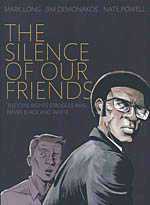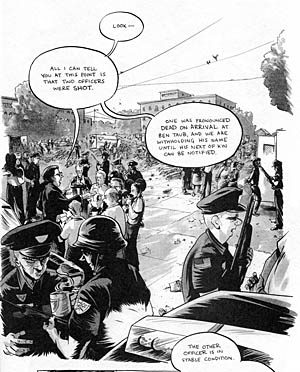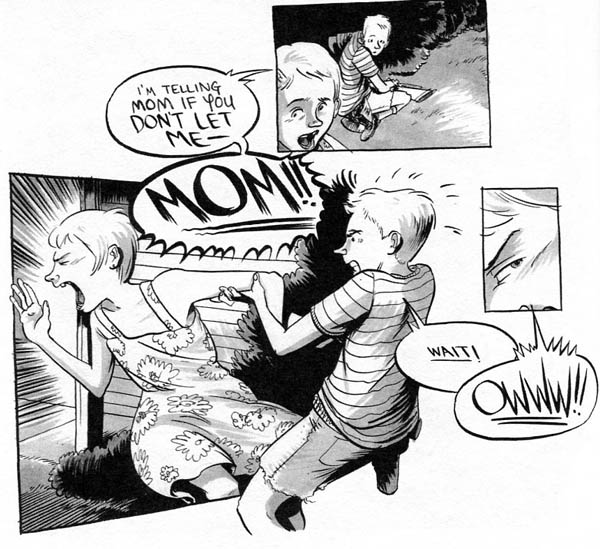 Written by Mark Long and Jim Demonakos
Written by Mark Long and Jim Demonakos
Art by Nate Powell
208 pages, black and white
Published by First Second Books
The retelling of events that you personally lived through is harder than it looks. Being there for what happened will automatically have a greater impact than hearing about it afterwards, and trying to bring that emotional connection to a wider audience can be difficult. The Silence of Our Friends is based on Mark Long’s childhood in 1968 Houston, and the end result is an interesting story, but one that isn’t quite as engaging as I suspect it was for Long.
Long and co-author Jim Demonakos introduce us to a Houston that is racially divided on a grand scale. There’s no interactions between people of different skin colors, and to even talk about it is anathema. There’s a sequence early on where parents Jim and Patricia Long find themselves a little disturbed by the language their children use to describe African-American people, noting that it wasn’t like that when they’d lived in San Antonio. This is a time when people are openly distributing flyers for KKK rallies, and segregation is alive and well. It’s this aspect of The Silence of Our Friends that is probably the strongest in terms of the writing; it’s easy to feel the tension and general nastiness that hangs over the area.
 Once the basic set-up is established, though, it’s hard to relate to either the Long family, or African-American professor Larry Thompson. The book goes through the motions of showing Jim and Larry’s slightly rocky relationship, but I never felt like I truly knew either of them, or felt like they were people that I personally was dying to see succeed. Obviously you want the racial tensions to go away and for Larry and Jim to get through the bad situation unscathed, but it’s in a slightly distant manner. This feels more like you’re watching a newscast about the main characters, rather than a documentary where you learn a lot about the people involved and learn to care about them. It’s frustrating, because the parts of the book where it feels slightly more human—seeing young Mark, Michelle, and Julie interact with the world around them—in some ways illustrates how much less developed Larry and Jim feel. Their reactions at times feel almost random because we haven’t gotten inside their heads or hearts the way that we do the children, and so while I was able to ultimately appreciate the story and this bit of history that few have heard of, I found myself just liking rather than loving the script.
Once the basic set-up is established, though, it’s hard to relate to either the Long family, or African-American professor Larry Thompson. The book goes through the motions of showing Jim and Larry’s slightly rocky relationship, but I never felt like I truly knew either of them, or felt like they were people that I personally was dying to see succeed. Obviously you want the racial tensions to go away and for Larry and Jim to get through the bad situation unscathed, but it’s in a slightly distant manner. This feels more like you’re watching a newscast about the main characters, rather than a documentary where you learn a lot about the people involved and learn to care about them. It’s frustrating, because the parts of the book where it feels slightly more human—seeing young Mark, Michelle, and Julie interact with the world around them—in some ways illustrates how much less developed Larry and Jim feel. Their reactions at times feel almost random because we haven’t gotten inside their heads or hearts the way that we do the children, and so while I was able to ultimately appreciate the story and this bit of history that few have heard of, I found myself just liking rather than loving the script.
More successful from start to finish is Nate Powell’s art. I’ve enjoyed his art on graphic novels like Swallow Me Whole and Any Empire, and he’s just as strong here. The kids in particular are remarkably expressive, and I love the way that we first meet Mark and Michelle; the way that Michelle is being tugged on by Mark as she tries to tell on him has an energy about it that feels remarkably real. The adults look good too, and scenes like the riot or the police station have a great level of detail and variety in how the people look. In many ways, I think it’s Powell’s art that transports you to 1968 Houston, providing us with the visuals to help fill in the gaps.

The Silence of Our Friends is a good book that I wish had been a great book. It ultimately couldn’t draw me into the story as much as I feel it needed to, and while I’m glad and pleased that I read it, it’s a book that won’t be as memorable as other biographical/historical comics I’ve read over the years. Still, it’s a nice debut from Long and Demonakos, and Powell’s art is as great as ever. If this trio ever worked on a second graphic novel, I’d be interested to see what they’ve learned from this and where they went from here. This is good for those interested in the struggle for racial equality, but it doesn’t hold as much of a universal appeal as it could have.
Purchase Links: Amazon.com | Powell’s Books
